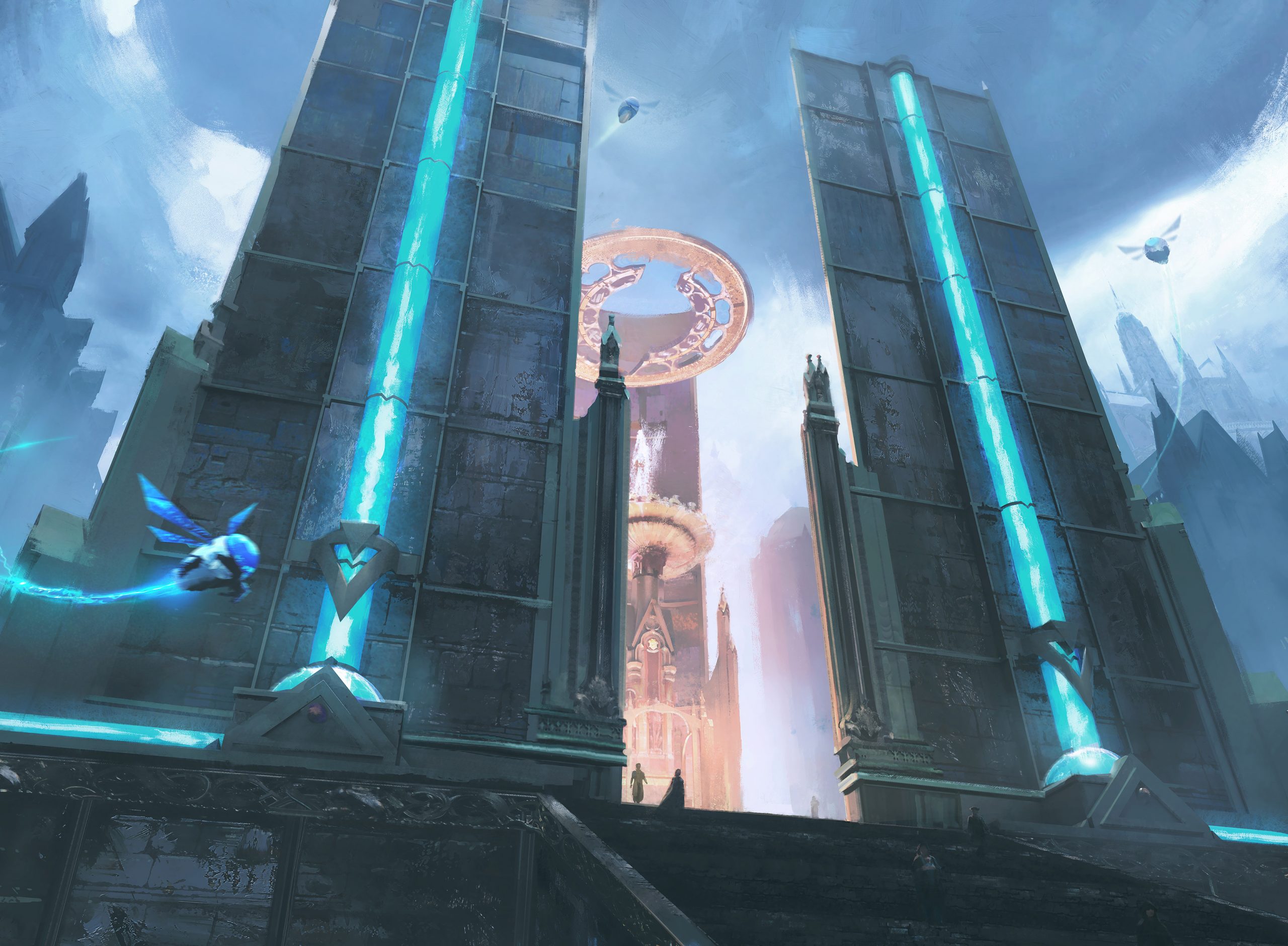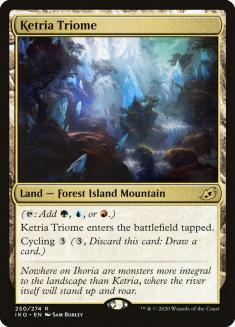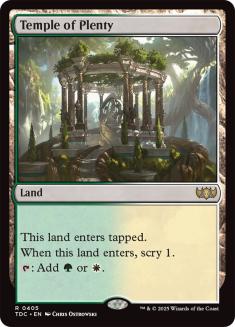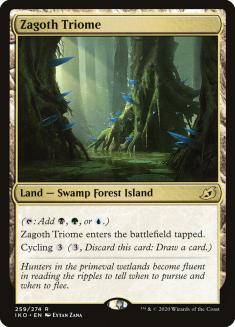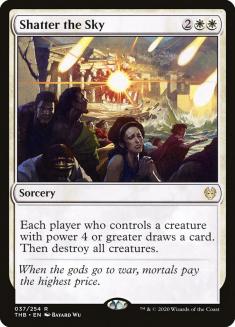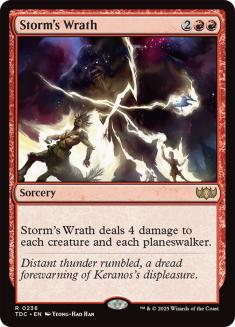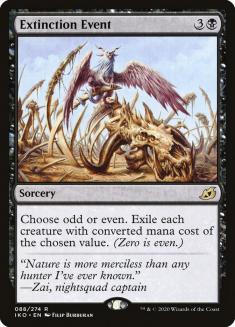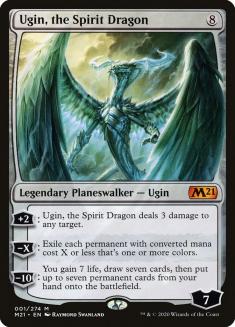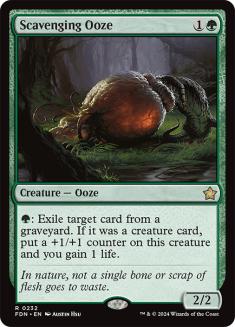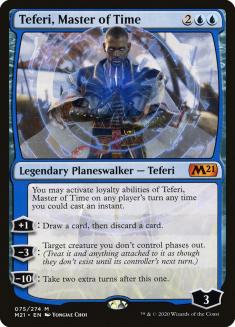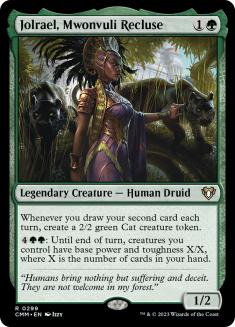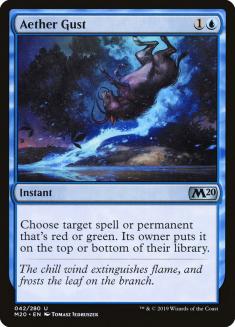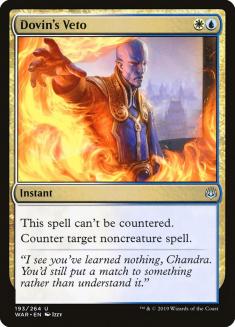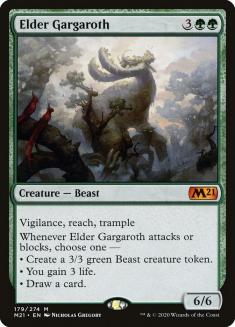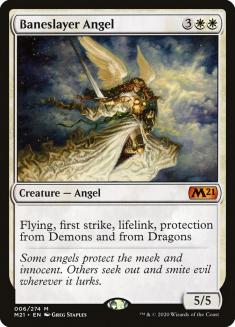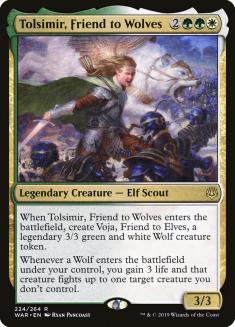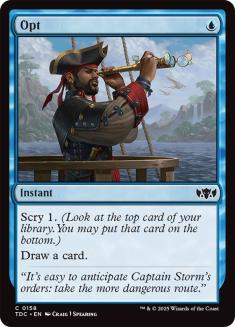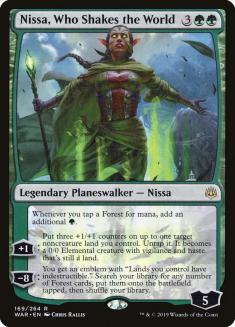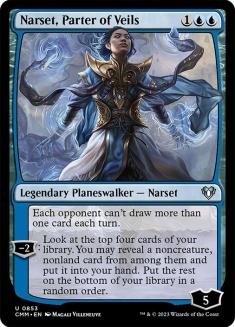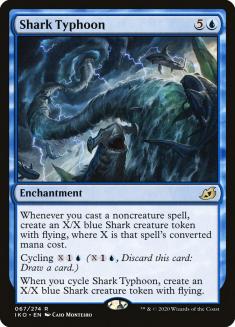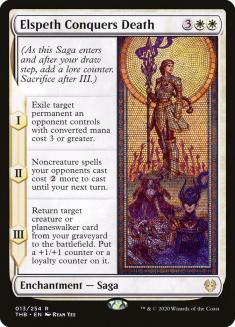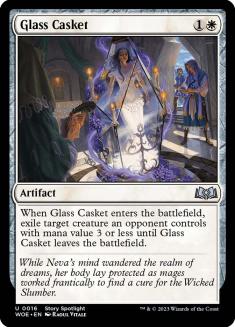Bant has gone by many titles over its time in Standard — Bant Midrange, Bant Control, Bant Ramp, and everything in between. This isn’t just because classifying decks is inherently vexing; it’s a sign of the colour combination’s flexibility that has kept it near the top of the Standard food chain as so much else has changed around it. This rewards players who can identify the right priorities in the format, but these choices can be daunting for new converts building their Bant list for this weekend’s tournament.
I’ll start with a brief tour of the successful Bant decks over the past few iterations of Standard to show what informs these choices. A Bant deck that was very clearly a ramp strategy appeared soon after the release of Theros Beyond Death:
Creatures (11)
Planeswalkers (10)
Lands (23)
Spells (16)
Sideboard

The key card in this format — and therefore this list — was Elspeth Conquers Death, an excellent card against Temur Reclamation and Jeskai Fires as seen in Paulo Vitor Damo da Rosa’s Worlds-winning Azorius Control deck. As Azorius Control faded away and Simic-based decks like Bant and Sultai rose up, this remained an important tool as it was the single best card in the (pseudo-) mirrors — you always wanted to have the last Elspeth Conquers Death and games were often decided by who drew and resolved more.
Bant decks at this time played not only the automatic four copies of Elspeth Conquers Death but Tamiyo, Collector of Tales – a perfect way to find it and set up unbeatable end-game loops with it. The usual ramp suite of Growth Spiral and Uro, Titan of Nature’s Wrath is joined here by Arboreal Grazer, allowing Elspeth Conquers Death to come down on a critical turn reliably even on the draw and mitigating its inherent clunkiness. This also enables the dream of Turn 3 Nissa, Who Shakes the World, a staple in these shells for good reason but also a top-shelf threat to return with Elspeth Conquers Death that leaves an attacker behind against an opposing copy and supercharges Hydroid Krasis, a threat that dodges Elspeth Conquers Death and cements your advantage in long games.
With Ikoria: Lair of Behemoths, Bant lists had to contend with new challenges — adapting to a format warped beyond recognition by companions and accommodating another twenty cards to unlock their own. As classic Keruga Jeskai Fires and then Yorion Jeskai Lukka took over Standard, this reactive approach to building Bant gained favour as cards like Mystical Dispute, Dovin’s Veto, and Neutralize kept the expensive, game-winning plays from Jeskai Lukka in check while Bant’s traditional haymakers could be exploited by Elspeth Conquers Death and Agent of Treachery backed up by Yorion, Sky Nomad.
In this setup, Shark Typhoon became the preferred mana sink over the likes of Hydroid Krasis as a flash threat that didn’t compete with counters and could work with them by applying pressure in an aggro-control role. Note the focus on Narset, Parter of Veils — an ideal target for Yorion, yes, but also a brutally powerful card against other blue decks and a way to find cards like Shatter the Sky or Mystical Dispute that are highly polarized in their effectiveness across matchups and often the card you most want to draw. Shark Typhoon complements Narset as a finisher it can find that can also defend it in a pinch.
The key here is that we have to evaluate cards not just in the context of the rest of the format but on how they form a cohesive whole in a particular build. The tools available to Bant are strong enough — either in general or at their intended task — that it’s easy to end up with a Bant list with high card quality carrying a lot of games but disguising weaknesses that become relevant in intricate games against tough competition. A macro-level and micro-level understanding of how and when these cards work is crucial to avoid this.
The Simic shell is clearly the best thing you can do in Standard — every Top 8 is a sea of Breeding Pools and Growth Spirals. Beyond that, every possible colour combination has seen success: Temur, Bant, Sultai, and straight Simic as a dedicated ramp deck. Other than Elspeth Conquers Death, what are the pros and cons of Bant?
Bant has tough mana requirements thanks to its reliance on Shatter the Sky and is worse at meeting them without a fully on-colour Triome. Shocklands, Fabled Passage, and Temples still do the job well enough but the fact that Temur and Sultai run Triomes over more copies of their own Temples shows how integral they are to those manabases. The land types matter too — Bant can’t justify a Castle Vantress as a utility land so easily and Bant’s Nissas are weaker without the four extra Forests enabling the Nissa into two-mana interaction lines that help make Nissa so scary to play against.
Then again, Louis-Samuel Deltour managed to Top 8 a Players Tour despite forgetting to put Hallowed Fountain in his deck…
Mono-Green Aggro has cemented itself as Standard’s default aggressive deck and Rakdos Sacrifice continues to put up an impressive win rate. Other aggro decks are unpopular individually but popular enough collectively to bump up aggro’s representation. Logan Nettles’s Standard Showcase win with four maindeck Storm’s Wrath in Temur Reclamation is a clear statement from one of the world’s best deckbuilders about the need to respect aggro in this format.
Drawing Shatter the Sky against aggro improves your odds in a game more than any other card in any other matchup even Teferi, Time Raveler against Temur Reclamation. This isn’t running up the score, either; Game 1 against Mono-Green Aggro is often not a game at all unless you have Shatter the Sky.
Shatter the Sky is the best monocoloured four-mana sweeper by a decent margin. Shatter and Storm’s Wrath are mostly the same against Rakdos Sacrifice but Mono-Green can field threats that survive Storm’s Wrath — Lovestruck Beast; some Stonecoil Serpents; most things with Gemrazer; anything with Vivien, Arkbow Ranger — and Extinction Event can’t get everything against the Pelt Collector starts that most demand a sweeper. Shatter the Sky can give them a card back but this is a much better price to pay than leaving a large threat behind.
The Four-Color Reclamation deck that David Inglis (AKA tangrams) used to qualify for the Mythic Invitational and Top 4 a SCG Tour Online Championship Qualifier has access to Solar Blaze, which is the ideal sweeper against Mono-Green but misses Serrated Scorpion and Priest of Forgotten Gods against Rakdos Sacrifice.
These details aside, Teferi, Time Raveler makes Bant’s sweepers substantially better. Instant-speed sweepers are harder to play against and vital against Mono-Green’s haste threats like Questing Beast; Nissa, Who Shakes the World; and Mobilized District. The combination of planeswalkers and sweepers presents a tough choice between overextending into a sweeper and putting less pressure on a planeswalker; Teferi makes that even trickier by removing a source of pressure and powering up the Shatter that’s the other half of that pincer. Bouncing your own creature that’s forced them to add more to the battlefield — most commonly Jolrael, Mwonvuli Recluse — is a rarer but powerful line.
Teferi’s game-warping impact against Temur Reclamation (still the best deck and the first litmus test in Standard) is the biggest draw to Bant. However, as Paulo highlights in his overview of Core Set 2021 for Bant, the Temur Reclamation matchup is only good if and when your other card choices care about it. Teferi accounts for most of your easy wins but the longer games still test the composition of your deck. Jolrael, Shark Typhoon, Brazen Borrower, and Mystical Dispute are all common and effective ways for Temur Reclamation to fight over or through Teferi.
The reprints Paulo discusses have earned mixed reviews so far. Ugin, the Spirit Dragon was poised to redefine Standard and end the midrange arms race by escalating it so far that any slower deck fighting over the battlefield couldn’t hope to compete. Simic Ramp sporting a full four copies has attempted to do that but with limited success.
This makes more sense when you line it up against the most popular decks. Against Mono-Green Aggro, it’s a sweeper that doesn’t hit Stonecoil Serpent, is still vulnerable to a follow-up Questing Beast, and is painfully slow — successfully resolving Shatter the Sky is already hard enough and most games where you make it to eight mana can be stabilized through other means. Ugin is almost impossible to resolve and protect against Temur Reclamation (and, if you do, Wilderness Reclamation can set up a lethal Explosion in a single turn). Bant and Sultai can re-trump Ugin with Elspeth Conquers Death or Casualties of War and sport cheap interaction like Mystical Dispute, Negate, and Dovin’s Veto that can tag Ugin in post-sideboard games.
Ugin’s strength alongside Nissa, Who Shakes the World is a double-edged sword. Animated lands are colourless and dodge the -X ability, so Ugin can’t always sweep the battlefield and can be picked off by a fresh Nissa if it has to. This weakness to Nissa can even be relevant against Temur Reclamation – Erin Diaz won an SCG Tour Online Championship Qualifier with an off-beat Temur Reclamation list with more Nissas than Reclamations and Javier Dominguez took a more conventional version with Nissa to the finals of the Red Bull Untapped International Qualifier II tournament.
The case for Ugin is that it wins games no other card in Standard could. Some archetypes — Jund Sacrifice, the Yorion Orzhov Blink deck that was popular for a hot minute — fear Ugin more than anything else. The threat of Ugin warps the entire game and the lack of Ugin gives opponents a lot more freedom to commit to the battlefield. Game 1 against Bant or Sultai goes long enough that you are likely to find Ugin and maneuver the game to use it effectively.
Scavenging Ooze looks like it should be an all-star, disrupting Uro and Elspeth Conquers Death in mirrors, chewing up Cauldron Familiar against Rakdos Sacrifice, and providing a crucial life buffer against aggressive decks. While these are useful applications in the abstract, investing a card and mana this way isn’t worth it reliably enough for a mana-hungry deck that cares strongly about both card quantity and card quality. Any card that doesn’t replace itself, generate mana, or solve a specific problem has to clear a high bar.
I also think Scavenging Ooze is worse than advertised in those situations. Mono-Green Aggro’s creatures are too large for Ooze to block well and Bant lacks the discard or targeted removal that let Ooze grow quickly in larger formats. Other Growth Spiral decks go over the top of the small-ball Magic that Ooze wants to play and can contain it easily if it does become a problem. Rakdos Sacrifice can fold to Ooze but can also get more from Priest of Forgotten Gods and Claim the Firstborn than they can or should normally.
Teferi, Master of Time’s power is less obvious than its predecessors’. It’s unlikely to oppress Standard for a year like Teferi, Time Raveler or be the cornerstone of a generation of control decks like Teferi, Hero of Dominaria. The newest and fairest Teferi may have a place here anyway — the card filtering is valuable for a deck that contains a range of situational cards, is prone to clunky draws, and is often low on fuel to escape Uro. The threat of instant-speed phasing makes combat difficult in a way that compounds itself the more planeswalkers you control (sometimes this Teferi’s job is running interference for its time-raveling cousin).
Jolrael, Mwonvuli Recluse seemed destined to be part of a typical transformational sideboard as a cheap creature that takes over games and goes under the midrange arms race or race combo when backed up by disruption. Jolrael quickly proved its worth as a maindeck card despite turning on otherwise dead removal – it only takes a few games on either side to realize how abruptly Jolrael turns the corner in a game. Growth Spiral, Uro, and Shark Typhoon provide enough ways to trigger Jolrael in a base-Simic deck but Teferi, Time Raveler is a vital addition to this list for Bant.
Jolrael arithmetic over several turns will be a crucial skill for anyone playing Core Set 2021 Standard. Note that Jolrael’s ability changes the base power and so works well with the +1/+1 counters on Hydroid Krasis or lands via Nissa, Who Shakes the World. Shark Typhoon can offer a surprise Jolrael trigger as well as another body, making a Jolrael activation unexpectedly lethal.
Changing your deck to accommodate maindeck Jolrael also frees up the sideboard slots it would occupy itself and makes room for more narrowly targeted sideboard cards for close matchups.
The value of conditional interaction varies widely in both individual games and the format at large. Now that Mono-Green is the aggressive deck of choice, Aether Gust is once again strong against the entire top tier of Standard and a worthy maindeck card. Gust works when you can capitalize on whatever nebulous ‘tempo’ you gain in that exchange with planeswalkers or other threats and is weak if it’s just a delaying tactic that puts you back in that position next turn. Jolrael helps a lot here (that one turn can be enough to let you cross the finish line).
Mystical Dispute continues to be fantastic in blue mirrors but a study of its play patterns highlights important differences between these blue decks. Consider its role in Temur Reclamation, which happily maindecks a few copies. Temur Reclamation is built to play primarily at instant speed, increasing the value of any one instant — your open mana can represent more things and you have more ways to use that mana if you don’t have to Dispute. The presence of cheap cantrips like Opt makes it easier to dig for and cast Dispute in one turn when it’s useful.
The threat of an unbeatable Wilderness Reclamation + Explosion end-game means opponents can’t often afford to wait until they can pay for a Dispute on a key card. Resolving Reclamation is critical and immediately offers a rebate on your mana so using a Dispute to force it through is more appealing. In back-and-forth stack battle, Expansion pairs well with Dispute to constrict the opponent’s mana and maximize yours. Dispute is the best answer to the scariest play of all — an early Teferi, Time Raveler. Finally, Dispute is the most efficient way to fight through an opponent’s Dispute, incentivizing players to run more and more copies for the counter wars it creates.
All these factors are different for Bant Ramp. There’s more tension between deploying your bigger, sorcery-speed threats and holding up Dispute and your mana is more likely to be wasted if you don’t use Dispute (a point in favour of Shark Typhoon as it addresses this and makes your sideboard configuration more cohesive). It’s harder to find and cast Dispute when you’re desperate.
No one card is central enough to your gameplan that you want to resolve it at all costs and your threats are expensive enough that waiting to resolve them stops Dispute from actually forcing them through consistently. You don’t live in fear of Teferi (though Narset, Parter of Veils is a key Dispute target if people agree with me about its positioning in current Standard). Games against other blue decks tend to go long and Dispute becomes dead surprisingly often. This expiration date on Dispute supports the case for proactive cards like Jolrael that contest the game during Dispute’s window of relevance.
To some extent, Mystical Dispute is a victim of its own success. Expensive blue cards like Sublime Epiphany or expensive cards in general like Ugin, the Spirit Dragon stay on the bench because of its prevalence. Dispute will always belong in a blue deck’s arsenal but using it properly requires an awareness of these dynamics.
The strength of Dovin’s Veto against Dispute makes it not just an upgrade to Negate but a draw to white in its own right. Maindeck Veto is the kind of measure that Paulo mentioned as necessary to shore up the Temur Reclamation matchup and it overperforms against the likes of Nissa, Elspeth Conquers Death, and Casualties of War even in drawn-out slugfests.
Core Set 2021 has expanded the roster of literal and figurative Baneslayers to place your chips on against aggressive decks. Tolsimir, Friend to Wolves is unique in removing Priest of Forgotten Gods and Mayhem Devil, which allow Rakdos Sacrifice to sidestep its alternatives. Unfortunately, it’s a joke against Mono-Green Aggro and that rules it out until further notice.
Baneslayer Angel is better than Elder Gargaroth against Questing Beast — the scariest threat in the best aggressive deck — and fringe players like Demonic Embrace or Embercleave. Gargaroth is the better blocker against Rakdos Sacrifice, which can prevent Baneslayer’s lifelink by sacrificing the creature it blocked but still triggers Elder Gargaroth. This tips a close choice towards Gargaroth for me, but there’s a bigger question of how necessary this effect is to begin with.
A wide variety of Bant shells have seen recent success. Louis-Samuel Deltour followed up his Hallowed Fountain-free Players Tour Top 8 with a business-as-usual win in the first SCG Tour Online Championship Qualifier and doubled down after Core Set 2021 by winning a Standard Challenge on Magic Online:
Creatures (8)
Planeswalkers (9)
Lands (22)
Spells (21)

Deltour’s emphasis on Aether Gust and Glass Casket lets him keep up with slower draws from Mono-Green Aggro while having much-needed cheap plays against the rest of the field. Glass Casket hitting Jolrael and Hydroid Krasis in Bant mirrors makes it less narrow than it appears.
Creatures (9)
- 1 Hydroid Krasis
- 1 Brazen Borrower
- 3 Uro, Titan of Nature's Wrath
- 1 Llanowar Visionary
- 3 Jolrael, Mwonvuli Recluse
Planeswalkers (6)
Lands (20)
Spells (25)

The inclusion of Opt (popularized by Piotr Glogowski) patches up some of Bant’s inherent inconsistencies while powering up Jolrael, Mwonvuli Recluse and Uro, Titan of Nature’s Wrath but brings some subtle costs. The old-school ‘Xerox’ approach of cutting lands as you add cantrips can’t work, as making land drops is all-important and your ramp spells in Growth Spiral and Uro ask you to have an extra land immediately. The Triome problem is felt keenly here; you need a certain quantity of lands just to have enough sources of each colour. When Opt replaces spells, your deck contains more air (Bant is already surprisingly prone to flooding) and you cut into cards like Elspeth Conquers Death or Nissa, Who Shakes the World that are often what you want to dig for in the first place.
Creatures (10)
Planeswalkers (9)
Lands (23)
Spells (18)

2016 Constructed Master Oliver Tiu streamed his run to #1 Mythic on Magic Arena with this build, which is likely to become the ‘stock’ list. The Hydroid Krasis count leapt to four as a joke but Tiu soon became a sincere advocate for it. In my experience, Krasis rewards you in situations that already favour your deck — you have survived to the mid-game and accumulated lots of resources — while being dead weight when you stumble. Though they aren’t in direct competition, the comparison with Shark Typhoon is illustrative; Typhoon is another great payoff for Nissa, Who Shakes the World (which rarely needs the help!) but can cycle to smooth an imperfect draw and fill a broader range of functions while cooperating with your reactive sideboard cards. However, Tiu’s success with Hydroid Krasis may be self-reinforcing as it excels in Bant mirrors.
Here’s a speculative list that incorporates these principles:
Creatures (6)
Planeswalkers (9)
- 4 Teferi, Time Raveler
- 3 Nissa, Who Shakes the World
- 1 Narset, Parter of Veils
- 1 Teferi, Master of Time
Lands (29)
Spells (16)

On top of its proven performance, Narset, Parter of Veils is a counter to Hydroid Krasis and Jolrael that digs deep for Shatter the Sky against one half of the format and Dovin’s Veto against the other.
The marginal card choices should account for the expected metagame — the third or even fourth Shatter the Sky is worth a look if you expect to play against more aggressive decks on the Magic Arena ladder.
VS Temur Reclamation
Out:
In:
Temur Reclamation is just as customizable as Bant Midrange and your sideboarding must be flexible – Aether Gust fluctuates in value depending on the presence of Jolrael and Nightpack Ambusher, for example. Building on the discussion above, have a plan for when to use Mystical Dispute – heuristics are useful so that you aren’t always figuring this out from first principles. This list is designed with Game 1 against Temur Reclamation in mind but it’s the best deck for a reason – the decisions are hard and mistakes are swiftly punished.
VS Bant Midrange
Out:
In:
Everything from the above paragraph applies here. In these matchups you have more good tools than you can present in a 60-card deck — it’s not that Aether Gust or Shark Typhoon is bad or that I have high confidence they are worse than other cards (even if they are in general, they surely won’t be against certain configurations).
VS Mono-Green Aggro
Out:
In:
It’s usually wise to keep a wider range of hands with Bant given how resource-heavy it is but this matchup is the exception — your deck is leaner, specific cards like Shatter the Sky matter a lot more, and a good start from Mono-Green Aggro will bulldoze a mediocre draw.
VS Rakdos Sacrifice
Out:
In:
Claim the Firstborn is a looming concern in this matchup; you often find yourself in a close mid-game with your life total dwindling, knowing that an escaped Uro will stabilize the game most of the time and lose it on the spot against Claim the Firstborn. Don’t be afraid to use Uro as ‘just’ a Revitalize; deliberately undersizing a Shark Typhoon activation so that your Shark trades and doesn’t survive combat is an unintuitive but often correct move.
Call it whatever you like — Bant Ramp will be a fixture of Standard until rotation. There’s a lot to know about it and many sources of disagreement but I hope this is a good foundation for your own experiment with it.

